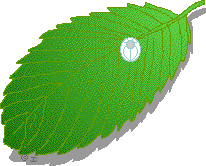 | Butterfly Gardens |  | 
Milkweed: Monarchs lay their eggs on milkweed leaves and Monarch caterpillars eat the leaves. | A successful butterfly garden has plants that meet butterfly's needs during all four life stages, the egg, caterpillar, chrysalis, and adult.
You can attract butterflies to your garden by providing them with food (plants and flowers), water, shelter, and places to lay their eggs (host plants). Butterflies drink nectar, so growing nectar-rich flowers will attract butterflies to your garden. Also, when their eggs hatch, the caterpillars eat the foliage of the plant they were laid on, so growing the right type of plants to feed caterpillars is important, since it will allow female butterflies to lay their eggs in your garden. |
PLANTS FOR NOURISHMENT AND PLANTS TO LAY EGGS ON
There are two different functions that plants serve for butterflies: nectaring plants, plants that the butterflies will sip nectar from and host plants, species specific plants that they can lay their eggs on (and the caterpillars will eventually eat).
NECTARING PLANTS
 Most butterflies only eat flower nectar. Different species of butterfly usually prefer different flowers, but they will generally feed on many types of flowers from plants, shrubs, vines, and trees. Most butterflies only eat flower nectar. Different species of butterfly usually prefer different flowers, but they will generally feed on many types of flowers from plants, shrubs, vines, and trees.
HOST PLANTS
 When it comes to laying their eggs, however, butterflies only lay them on the plant that the caterpillar will eventually eat (this differs from species to species). The eggs are frequently laid on the underside of leaves. When it comes to laying their eggs, however, butterflies only lay them on the plant that the caterpillar will eventually eat (this differs from species to species). The eggs are frequently laid on the underside of leaves.
Caterpillars mostly eat leaves; usually the leaves that they were laid on.
 The chrysalis (pupa) does not eat, but needs a sheltered environment. It frequently hangs from a twig and is often camouflaged. The chrysalis (pupa) does not eat, but needs a sheltered environment. It frequently hangs from a twig and is often camouflaged.
GOOD PLANTS FOR BUTTERFLIES
 Plan your garden so that there are flowers much of the year, so that there is a steady supply of nectar for the butterflies. Plan your garden so that there are flowers much of the year, so that there is a steady supply of nectar for the butterflies.
Sunlight: Butterflies use sunlight to regulate their body temperature. They need sunlight to keep themselves warm, but the outside temperature can also become too hot for them. A good butterfly garden should provide both sunny places and shady places where butterflies can cool off while they eat.

Buddleia (pronounced BUD-lee-ah), also called butterfly bush, has lilac-shaped blossoms whose sweet nectar attracts many species of butterflies, moths, hummingbirds, and bees. This easy-to-grow deciduous shrub blooms from mid to late summer and is a magnet for Western Checkerspots, swallowtails, buckeyes, Red Admirals, Echo Blues, and many other butterflies. Also, during the fall, buddleia seeds will feed birds. There are about 70 species of the Buddleia genus. | The following are common, easy-to-grow plants that attract many butterflies
•Butterfly Bush (Buddleia)
•Lantana
•Zinnias
•Bee balm
•Purple coneflowers
•Pentas
•Sage
•Butterfly Weed (Asclepias tuberosa) or other milkweeds
•Lilac
•Sunflower
•Marjoram
•Hebe
(these will attract many local butterflies).
Do not use insecticides in your garden! They will kill butterflies and caterpillars.
The first step is to determine which species thrive in your area, then determine what host plant the butterfly needs - see the table below.
Butterflies and The Plants Their Caterpillars Eat | Butterfly | Host Plant
(The plant that the butterfly will lay its egg on and the caterpillar will later eat. | | Monarch and The Queen | milkweed | | Pipevine Swallowtail | pipevine, snakeroot, and knot vine | | Black Swallowtail | parsley, carrots, parsnips | | Anise swallowtail | anise, fennel, carrots, parsley, parsnips | | Orange-Barred Sulphur | Cassia and the pea family | | Cloudless sulphur | wild senna | | Sara Orange Tip | wild mustard | | Southern Dogface | wild indigo and clover | | Great Southern White | mustards | | Julia, Gulf Fritillary, Zebras | passion flower leaves | | Greater Fritillaries and Lesser Fritillaries | violets | | Diana | manure piles | | Filed Crescent | asters | | Painted Lady and Mylitta Crescent | thistles | | Question Mark | elm | | Satyr | nettles | | Fawn | birch, alder | | Zephyr | elm and currant | | Comma | nettle and hops | | Buckeye | plantain and gerardia | | West Coast Lady and Grizzled Skipper | mallows | | Red Admiral and Milbert's Tortoise Shell | nettles | | Mourning Cloak | elm, willow, and poplar | | White Admiral | birch, willow, and poplar | | Viceroy | willow and poplar | | Red-Spotted Purple | wild cherry | | California sister | live oak | | Nais Metalmark | wild plum | | American Copper | sheep sorrel | | Eastern Tailed Blue, Orange-Bordered Blue | legumes | | Pygmy Blue and Dwarf Blue | lamb's tongue | | Common Blue | dogwood flowers | | Marine Blue | buds and blossoms of wisteria, alfalfa, locoweed, and legumes | | Southern Cloudy Wing and Northern Cloudy Wing | clover and legumes | | Silver Spotted Skipper | wisteria and locusts | |
 Free Forum Hosting
Free Forum Hosting